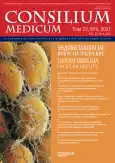Pioglitazone is a forgotten hypoglycemic drug with proven cardioprotective and nephroprotective properties
- Authors: Pesheva E.D.1, Fadeev V.V.1
-
Affiliations:
- Sechenov First Moscow State Medical University (Sechenov University)
- Issue: Vol 23, No 4 (2021)
- Pages: 366-371
- Section: Articles
- URL: https://journals.rcsi.science/2075-1753/article/view/95453
- DOI: https://doi.org/10.26442/20751753.2021.4.200892
- ID: 95453
Cite item
Full Text
Abstract
Full Text
##article.viewOnOriginalSite##About the authors
Ekaterina D. Pesheva
Sechenov First Moscow State Medical University (Sechenov University)врач-эндокринолог Moscow, Russia
Valentin V. Fadeev
Sechenov First Moscow State Medical University (Sechenov University)
Email: walfad@mail.ru
д-р мед. наук, проф., врач-эндокринолог, зав. каф. эндокринологии Moscow, Russia
References
- Morrish NJ, Wang SL, Stevens LK, et al. Mortality and causes of death in the WHO multinational study of vascular disease in diabetes. Diabetologia. 2001;44:S14-S21.
- Rawshani A, Rawshani A, Franzen S, et al. Mortality and cardiovascular disease in type 1 and type 2 diabetes. New Engl J Med. 2017;376:1407-18.
- UK Prospective Diabetes Study (UKPDS) Group. Intensive blood-glucose control with sulphonylureas or insulin compared with conventional treatment and risk of complications in patients with type 2 diabetes (UKPDS 33). Lancet 1998;352:837-53.
- Gerstein HC, Miller ME, Byington RP, et al. Effects of intensive glucose lowering in type 2 diabetes. New Engl J Med. 2008;358:2545-59.
- Phillips SA, Ciaraldi TP, Kong AP, et al. Modulation of circulating and adipose tissue adiponectin levels by antidiabetic therapy. Diabetes. 2003;52(3):667-74.
- Yki-Jarvinen H. Thiazolidinediones. New Engl J Med. 2004;351:1106-18.
- Belfort R, Harrison SA, Brown K, et al. A placebo-controlled trial of pioglitazone in subjects with nonalcoholic steatohepatitis. N Engl J Med. 2006;355(22):2297-307.
- Choi D, Kim SK, Choi SH, et al. Preventative effects of rosiglitazone on restenosis after coronary stent implantation in patients with type 2 diabetes. Diabetes Care. 2004;27:2654-60.
- Mazzone T, Meyer PM, Feinstein SB, et al. Effect of pioglitazone compared with glimepiride on carotid intima-media thickness in type 2 diabetes:a randomized trial. JAMA. 2006;296:2572-81.
- Kernan WN, Viscoli CM, Furie KL, et al. Pioglitazone after ischemic stroke or transient ischemic attack. New Engl Med. 2016;374:1321-31.
- Sinha B, Ghosal S. Assessing the need for pioglitazone in the treatment of patients with type 2 diabetes:a meta-analysis of its risks and benefits from prospective trials. Sci Rep. 2020;10(1):15781.
- De Jong M, Vander Worp HB, Vander Graaf Y, et al. Pioglitazone and the secondary prevention of cardiovascular disease. A meta-analysis of randomized-controlled trials. Cardiovasc Diabetol. 2017;16:134. doi: 10.1186/s12933-017-0617-4
- Erdmann E, Harding S, Lam H, et al. Ten-year observational follow-up of PROactive:a randomized cardiovascular outcomes trial evaluating pioglitazone in type 2 diabetes. Diabetes Obes Metab. 2016;18:266-73.
- Dormandy JA, Charbonnel B, Eckland DJ, et al. Secondary prevention of macrovascular events in patients with type 2 diabetes in the PROactive study (PROspective pioglitazone clinical trial in macrovascular events):a randomized controlled trial. Lancet. 2005;366:1279-89.
- Liao HW, Saver JL, Wu YL, et al. Pioglitazone and cardiovascular outcomes in patients with insulin resistance, pre-diabetes and type 2 diabetes:a systematic review and meta-analysis. BMJ Open. 2017;7:e013927.
- Yaghi S, Furie KL, Viscoli CM, et al. Pioglitazone prevents stroke in patients with a recent transient ischemic attack or ischemic stroke: a planned secondary analysis of the IRIS trial (insulin resistance intervention after stroke). Circulation. 2018;137:455-63. doi: 10.1161/CIRCULATIONAHA.117.030458
- DeFronzo RA, Mehta RJ, Schnure JJ. Pleiotropic effects of thiazolidinediones:implications for the treatment of patients with type 2 diabetes mellitus. Hosp Pract. 2013;41:132-47.
- Kumar J, Memon RS, Shahid I, et al. Antidiabetic drugs and non-alcoholic fatty liver disease: A systematic review, meta-analysis and evidence map. Dig Liver Dis. 2021;53(1):44-51.
- Nesto R, Bell D, Bonow R, et al. Thiazolidinedione use, fluid retention, and congestive heart failure: a consensus statement from the American Heart Association and American Diabetes Association. Diabetes Care. 2004;27(1):256-63. doi: 10.2337/diacare.27.1.256
- Lago R, Singh P, Nesto R. Congestive heart failure and cardiovascular death in patients with prediabetes and type 2 diabetes given thiazolidinediones:a meta-analysis of randomised clinical trials. Lancet. 2007;370:1129-36.
- Tang H, Shi W, Fu S, et al. Pioglitazone and bladder cancer risk:a systematic review and metaanalysis. Cancer Med. 2018;7(4):1070-80.
- DeFronzo RA, Inzucchi S, Abdul-Ghani M, Nissen SE. Pioglitazone: the forgotten, costeffective cardioprotective drug for type 2 diabetes. Diab Vasc Dis Res. 2019;16(2):133-43. doi: 10.1177/1479164118825376
- Aghamohammadzadeh N, Niafar M, Dalir Abdolahinia E, et al. The effect of pioglitazone on weight, lipid profile and liver enzymes in type 2 diabetic patients. Ther Adv Endocrinol Metab. 2015;6(2):56-60. doi: 10.1177/2042018815574229
- Schernthaner G, Currie CJ, Schernthaner GH. Do we still need pioglitazone for the treatment of type 2 diabetes? A risk-benefit critique in 2013. Diabetes Care. 2013 Aug;36 Suppl. 2(Suppl. 2):S155-61. doi: 10.2337/dcS13-2031
Supplementary files






